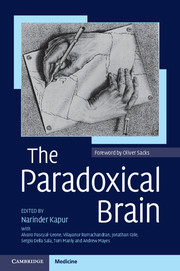Book contents
- Frontmatter
- Contents
- Acknowledgements
- Preface
- Foreword
- Author affiliations
- Abbreviations
- 1 The paradoxical nature of nature
- 2 Paradoxical effects of sensory loss
- 3 Paradoxical functional facilitation and recovery in neurological and psychiatric conditions
- 4 Paradoxes in neurorehabilitation
- 5 The paradoxical self
- 6 Paradoxical psychological functioning in early child development
- 7 Cognitive ageing: a positive perspective
- 8 Paradoxes of learning and memory
- 9 The paradox of human expertise: why experts get it wrong
- 10 Paradoxes in Parkinson's disease and other movement disorders
- 11 Paradoxical phenomena in epilepsy
- 12 Paradoxical creativity and adjustment in neurological conditions
- 13 Paradoxical functional facilitation with noninvasive brain stimulation
- 14 Unexpected benefits of allergies and cigarette smoking: two examples of paradox in neuroepidemiology
- 15 The paradox of autism: why does disability sometimes give rise to talent?
- 16 Paradoxes in creativity and psychiatric conditions
- 17 The paradox of psychosurgery to treat mental disorders
- 18 The paradox of electroconvulsive therapy
- 19 Paradoxes of comparative cognition
- 20 Paradoxical phenomena in brain plasticity
- 21 Immature neurons in the adult brain. Breaking all the rules
- 22 The paradoxical hippocampus: when forgetting helps learning
- 23 Paradoxical effects of drugs on cognitive function: the neuropsychopharmacology of the dopamine and other neurotransmitter systems
- 24 The paradoxical brain – so what?
- Index
- References
15 - The paradox of autism: why does disability sometimes give rise to talent?
Published online by Cambridge University Press: 05 December 2011
- Frontmatter
- Contents
- Acknowledgements
- Preface
- Foreword
- Author affiliations
- Abbreviations
- 1 The paradoxical nature of nature
- 2 Paradoxical effects of sensory loss
- 3 Paradoxical functional facilitation and recovery in neurological and psychiatric conditions
- 4 Paradoxes in neurorehabilitation
- 5 The paradoxical self
- 6 Paradoxical psychological functioning in early child development
- 7 Cognitive ageing: a positive perspective
- 8 Paradoxes of learning and memory
- 9 The paradox of human expertise: why experts get it wrong
- 10 Paradoxes in Parkinson's disease and other movement disorders
- 11 Paradoxical phenomena in epilepsy
- 12 Paradoxical creativity and adjustment in neurological conditions
- 13 Paradoxical functional facilitation with noninvasive brain stimulation
- 14 Unexpected benefits of allergies and cigarette smoking: two examples of paradox in neuroepidemiology
- 15 The paradox of autism: why does disability sometimes give rise to talent?
- 16 Paradoxes in creativity and psychiatric conditions
- 17 The paradox of psychosurgery to treat mental disorders
- 18 The paradox of electroconvulsive therapy
- 19 Paradoxes of comparative cognition
- 20 Paradoxical phenomena in brain plasticity
- 21 Immature neurons in the adult brain. Breaking all the rules
- 22 The paradoxical hippocampus: when forgetting helps learning
- 23 Paradoxical effects of drugs on cognitive function: the neuropsychopharmacology of the dopamine and other neurotransmitter systems
- 24 The paradoxical brain – so what?
- Index
- References
Summary
Summary
We explore why people with autism spectrum conditions (ASC) not only show deficits but also areas of intact or even superior skill. The deficits are primarily social; the areas of intact or superior skill involve attention to detail and systemizing. Systemizing is the drive to analyse or build a system. We review the evidence related to systemizing in ASC and discuss its association with sensory hypersensitivity. We close by considering the evolution and adaptive features of systemizing and how – taken to an extreme – this can also give rise to disability.
Introduction
Paradoxes emanating from human brain functioning have long been noted – patients with amnesia who cannot explicitly recall information but who nevertheless reveal implicitly that they do recall information; patients with reported blindness who nevertheless demonstrate some ‘unconscious’ vision (‘blindsight’); Brazilian street children who fail academic mathematics tests but who are lightening quick in performing calculations in the market place; and individuals who experience perceptions in one sensory modality when a different sensory modality is stimulated (‘synaesthesia’). In some sense, paradoxes in brain functioning should perhaps not be so surprising given the number of different ‘modules’ and pathways in the brain, such that some functions may be impaired whilst others may simultaneously be either intact or even superior.
Whilst we are familiar with syndromes where most, if not all, cognitive functions are impaired (such as in certain forms of learning disability or dementia), this chapter focuses on what can be learnt from syndromes displaying uneven cognitive profiles.
- Type
- Chapter
- Information
- The Paradoxical Brain , pp. 274 - 288Publisher: Cambridge University PressPrint publication year: 2011
References
- 13
- Cited by



